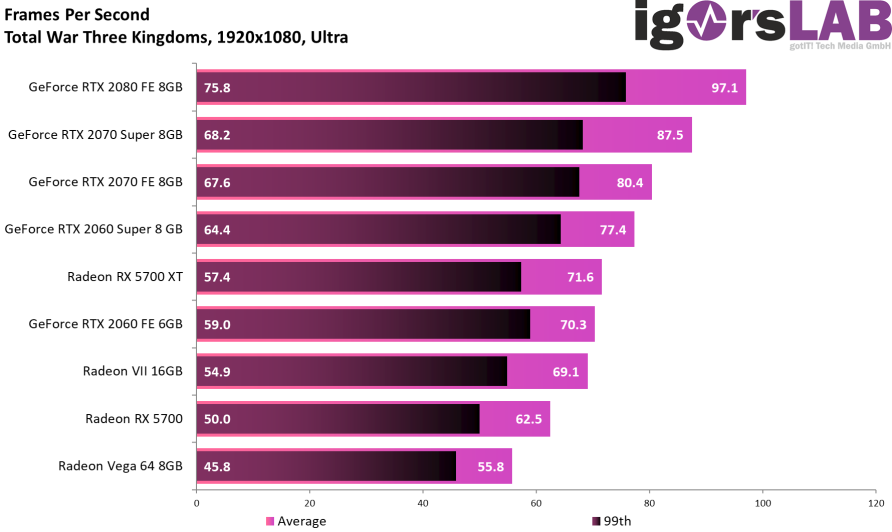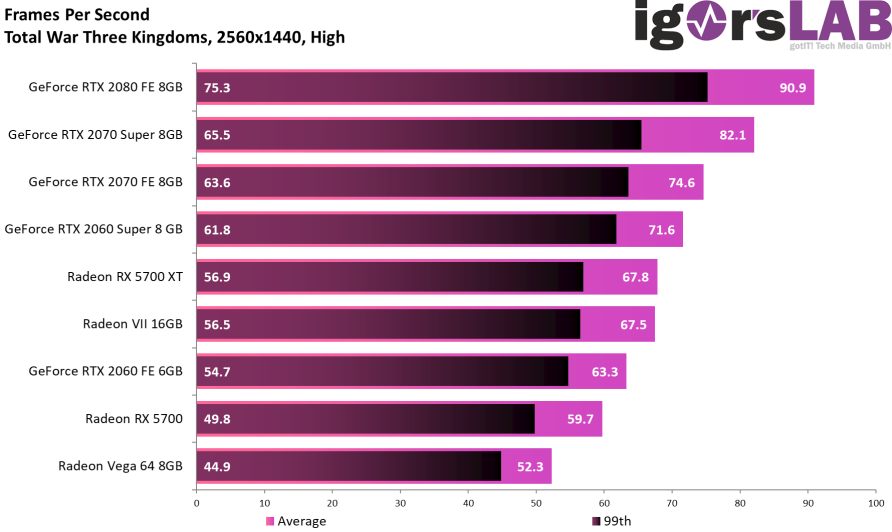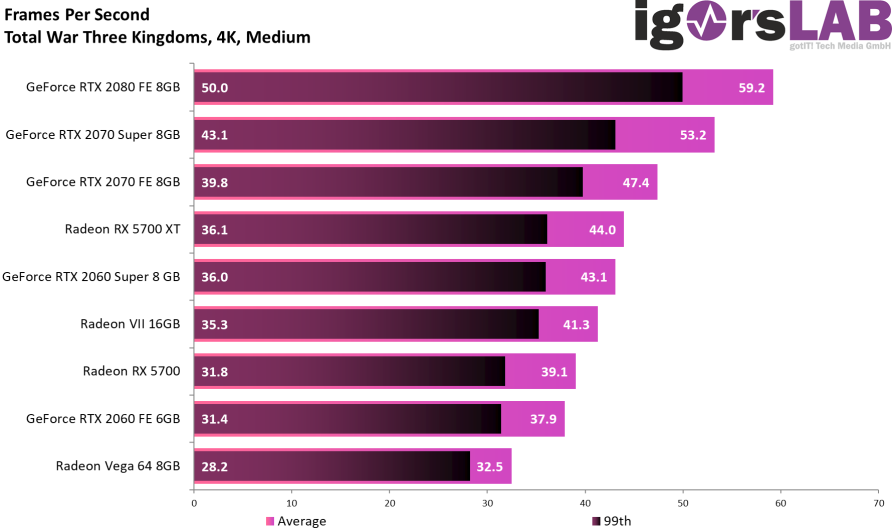This is a very interesting title, because the game can also use 8 (and more) threads wisely. For the GPU test, however, I use the benchmark scene for the career, because here the graphics load is a bit higher and the CPU is not quite as busy. The benchmark of a larger battle is perfect for CPU testing, but it doesn't take the graphics card quite as extreme. The title is very new, so the AMD driver clearly doesn't seem to be up to date yet. I will, of course, observe that. But for all lovers of the red stickers on the packaging, then i would like to refer to the next (and for today also last) benchmark, for which I will use a volcano game. So don't shed tears right away. And: drivers also mature (usually).
Benchmarks in Full HD with 1920 x 1080 pixels
I have deliberately chosen the highest settings for these benchmarks, as all maps here provide very useful frame rates.

The curves for the FPS gradient, the frametimes, and the percentiles provide further information about what beams cannot fully predict.

Total War Three Kingdoms - AvFPSoB - 1920x1080 Ultra

Total War Three Kingdoms - FPS99th - 1920x1080 Ultra

Total War Three Kingdoms - FrameTimeoB - 1920x1080 Ultra
And now again all the cards individually with the frametime variances, the actual frametimes and of course the Unevenness index (playability and immersion).

Total War Three Kingdoms - AvFPSoB - 1920x1080 Ultra

Total War Three Kingdoms - FPS99th - 1920x1080 Ultra

Total War Three Kingdoms - FrameTimeoB - 1920x1080 Ultra
Benchmarks in QHD with 2560 x 1440 pixels
The settings for these resolutions can still be chosen as high throughout, but it is already a compromise for better playability.

The curves for the FPS gradient, the frametimes, and the percentiles provide further information about what beams cannot fully predict.

Total War Three Kingdoms - AvFPSoB - 2560x1440 High

Total War Three Kingdoms - FPS99th - 2560x1440 High

Total War Three Kingdoms - FrameTimeoB - 2560x1440 High
And now again all the cards individually with the frametime variances, the actual frametimes and of course the Unevenness index (playability and immersion).

Total War Three Kingdoms - GeForce RTX 2060 FE 6GB - FPSvsFrameTimeDiff - 2560x1440 High

Total War Three Kingdoms - GeForce RTX 2060 FE 6GB - FrameTimeSolo - 2560x1440 High

Total War Three Kingdoms - GeForce RTX 2060 FE 6GB - Unevenness - 2560x1440 High

Total War Three Kingdoms - GeForce RTX 2060 Super 8 GB - FPSvsFrameTimeDiff - 2560x1440 High

Total War Three Kingdoms - GeForce RTX 2060 Super 8 GB - FrameTimeSolo - 2560x1440 High

Total War Three Kingdoms - GeForce RTX 2060 Super 8 GB - Unevenness - 2560x1440 High

Total War Three Kingdoms - GeForce RTX 2070 FE 8GB - FPSvsFrameTimeDiff - 2560x1440 High

Total War Three Kingdoms - GeForce RTX 2070 FE 8GB - FrameTimeSolo - 2560x1440 High

Total War Three Kingdoms - GeForce RTX 2070 FE 8GB - Unevenness - 2560x1440 High

Total War Three Kingdoms - GeForce RTX 2070 Super 8GB - FPSvsFrameTimeDiff - 2560x1440 High

Total War Three Kingdoms - GeForce RTX 2070 Super 8GB - FrameTimeSolo - 2560x1440 High

Total War Three Kingdoms - GeForce RTX 2070 Super 8GB - Unevenness - 2560x1440 High

Total War Three Kingdoms - GeForce RTX 2080 FE 8GB - FPSvsFrameTimeDiff - 2560x1440 High

Total War Three Kingdoms - GeForce RTX 2080 FE 8GB - FrameTimeSolo - 2560x1440 High

Total War Three Kingdoms - GeForce RTX 2080 FE 8GB - Unevenness - 2560x1440 High

Total War Three Kingdoms - Radeon RX 5700 - FPSvsFrameTimeDiff - 2560x1440 High

Total War Three Kingdoms - Radeon RX 5700 - FrameTimeSolo - 2560x1440 High

Total War Three Kingdoms - Radeon RX 5700 - Unevenness - 2560x1440 High

Total War Three Kingdoms - Radeon RX 5700 XT - FPSvsFrameTimeDiff - 2560x1440 High

Total War Three Kingdoms - Radeon RX 5700 XT - FrameTimeSolo - 2560x1440 High

Total War Three Kingdoms - Radeon RX 5700 XT - Unevenness - 2560x1440 High

Total War Three Kingdoms - Radeon Vega 64 8GB - FPSvsFrameTimeDiff - 2560x1440 High

Total War Three Kingdoms - Radeon Vega 64 8GB - FrameTimeSolo - 2560x1440 High

Total War Three Kingdoms - Radeon Vega 64 8GB - Unevenness - 2560x1440 High

Total War Three Kingdoms - Radeon VII 16GB - FPSvsFrameTimeDiff - 2560x1440 High

Total War Three Kingdoms - Radeon VII 16GB - FrameTimeSolo - 2560x1440 High

Total War Three Kingdoms - Radeon VII 16GB - Unevenness - 2560x1440 High
Benchmarks in Ultra HD with 3840 x 2160 pixels
Ultra-HD works well if you adjust the settings even further down. For me, the benchmark design is primarily about playability and only second only to absolute beauty.

The curves for the FPS gradient, the frametimes, and the percentiles provide further information about what beams cannot fully predict.

Total War Three Kingdoms - AvFPSoB - 4K Medium

Total War Three Kingdoms - FPS99th - 4K Medium

Total War Three Kingdoms - FrameTimeoB - 4K Medium
And now again all the cards individually with the frametime variances, the actual frametimes and of course the Unevenness index (playability and immersion).

Total War Three Kingdoms - GeForce RTX 2060 FE 6GB - FPSvsFrameTimeDiff - 4K Medium

Total War Three Kingdoms - GeForce RTX 2060 FE 6GB - FrameTimeSolo - 4K Medium

Total War Three Kingdoms - GeForce RTX 2060 FE 6GB - Unevenness - 4K Medium

Total War Three Kingdoms - GeForce RTX 2060 Super 8 GB - FPSvsFrameTimeDiff - 4K Medium

Total War Three Kingdoms - GeForce RTX 2060 Super 8 GB - FrameTimeSolo - 4K Medium

Total War Three Kingdoms - GeForce RTX 2060 Super 8 GB - Unevenness - 4K Medium

Total War Three Kingdoms - GeForce RTX 2070 FE 8GB - FPSvsFrameTimeDiff - 4K Medium

Total War Three Kingdoms - GeForce RTX 2070 FE 8GB - FrameTimeSolo - 4K Medium

Total War Three Kingdoms - GeForce RTX 2070 FE 8GB - Unevenness - 4K Medium

Total War Three Kingdoms - GeForce RTX 2070 Super 8GB - FPSvsFrameTimeDiff - 4K Medium

Total War Three Kingdoms - GeForce RTX 2070 Super 8GB - FrameTimeSolo - 4K Medium

Total War Three Kingdoms - GeForce RTX 2070 Super 8GB - Unevenness - 4K Medium

Total War Three Kingdoms - GeForce RTX 2080 FE 8GB - FPSvsFrameTimeDiff - 4K Medium

Total War Three Kingdoms - GeForce RTX 2080 FE 8GB - FrameTimeSolo - 4K Medium

Total War Three Kingdoms - GeForce RTX 2080 FE 8GB - Unevenness - 4K Medium

Total War Three Kingdoms - Radeon RX 5700 - FPSvsFrameTimeDiff - 4K Medium

Total War Three Kingdoms - Radeon RX 5700 - FrameTimeSolo - 4K Medium

Total War Three Kingdoms - Radeon RX 5700 - Unevenness - 4K Medium

Total War Three Kingdoms - Radeon RX 5700 XT - FPSvsFrameTimeDiff - 4K Medium

Total War Three Kingdoms - Radeon RX 5700 XT - FrameTimeSolo - 4K Medium

Total War Three Kingdoms - Radeon RX 5700 XT - Unevenness - 4K Medium

Total War Three Kingdoms - Radeon Vega 64 8GB - FPSvsFrameTimeDiff - 4K Medium

Total War Three Kingdoms - Radeon Vega 64 8GB - FrameTimeSolo - 4K Medium

Total War Three Kingdoms - Radeon Vega 64 8GB - Unevenness - 4K Medium

Total War Three Kingdoms - Radeon VII 16GB - FPSvsFrameTimeDiff - 4K Medium

Total War Three Kingdoms - Radeon VII 16GB - FrameTimeSolo - 4K Medium

Total War Three Kingdoms - Radeon VII 16GB - Unevenness - 4K Medium







































































































Kommentieren